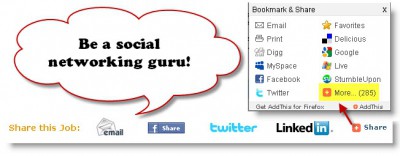Build a Recruitment Brand, And They Will Come…(Part 2)
You may recall from “Part 1” of this story the emphasis I placed on creating and nurturing a recruitment brand for your organization. Because whether or not you address it, you have a brand…so make sure it is a recruitment brand you are proud to support!
In this post, we’ll take a quick look at how you may use applicant tracking software to help maintain the recruitment brand you worked so diligently to create. Specifically, we’ll look at an ATS as a launch pad to social networking platforms; as well as, a means by which you can easily use status codes to move candidates through the selection process–while keeping those candidates informed.
But first, after my last post I invited ExactHire client, Right On Interactive, to share how they create and maintain the Right On Interactive recruitment brand.
Here are Right On Interactive’s President Troy Burk’s thoughts on the subject:
- “We educate as much as we evaluate. We realize that throughout the entire recruiting process we must continue to show the value of the opportunity, the potential for personal growth, and future direction of our company. The candidates are interviewing us as much as we are interviewing them.
- Be honest with the candidates. We talk about the specifics of the position, the requirements, and what our expectations are for performance. False expectations on either end will end in disappointment (on either side).
- If a candidate is not a good fit for the position, we will try to help them network with others that might be a better fit. We have done this with several individuals and helped them find the right position (with another company).”
It is clear that Troy’s organization understands the importance of mutual respect in the selection process, as well as how to leverage networking to help candidates.
So how can you use an ATS to exponentially increase the size of the audience that has access to your job postings? With ExactHire’s applicant tracking software, you have the ability to allow candidates to “share” your job listing with friends and colleagues via the biggie’s like Facebook, Twitter, and LinkedIn, but also over 285 other Internet sites! And, if you have been paying special attention to your recruitment brand and how it dictates that you treat your applicants, you are much more likely to have site visitors that want to share your openings with others. Your recruitment brand is creating fans for your organization.

When you have the social networking under control, then it is time to keep applicants engaged by managing them through your selection process within the ATS. The administrative side of the ExactHire ATS allows you to use both applicant status codes and job status codes to assign a progress label to every applicant for each position to which he/she may have applied. Then, you may run a quick report that allows you to use status codes as search criteria to drill down to specific lists of applicants that deserve a follow-up email from your organization. Use the ATS to send emails to multiple candidates at once, and create a recruitment brand that embodies consistency in candid communication. Your applicants will note your efforts, trust me.
Image credit: Road Herd by Ed Thomes Photography (contact)
